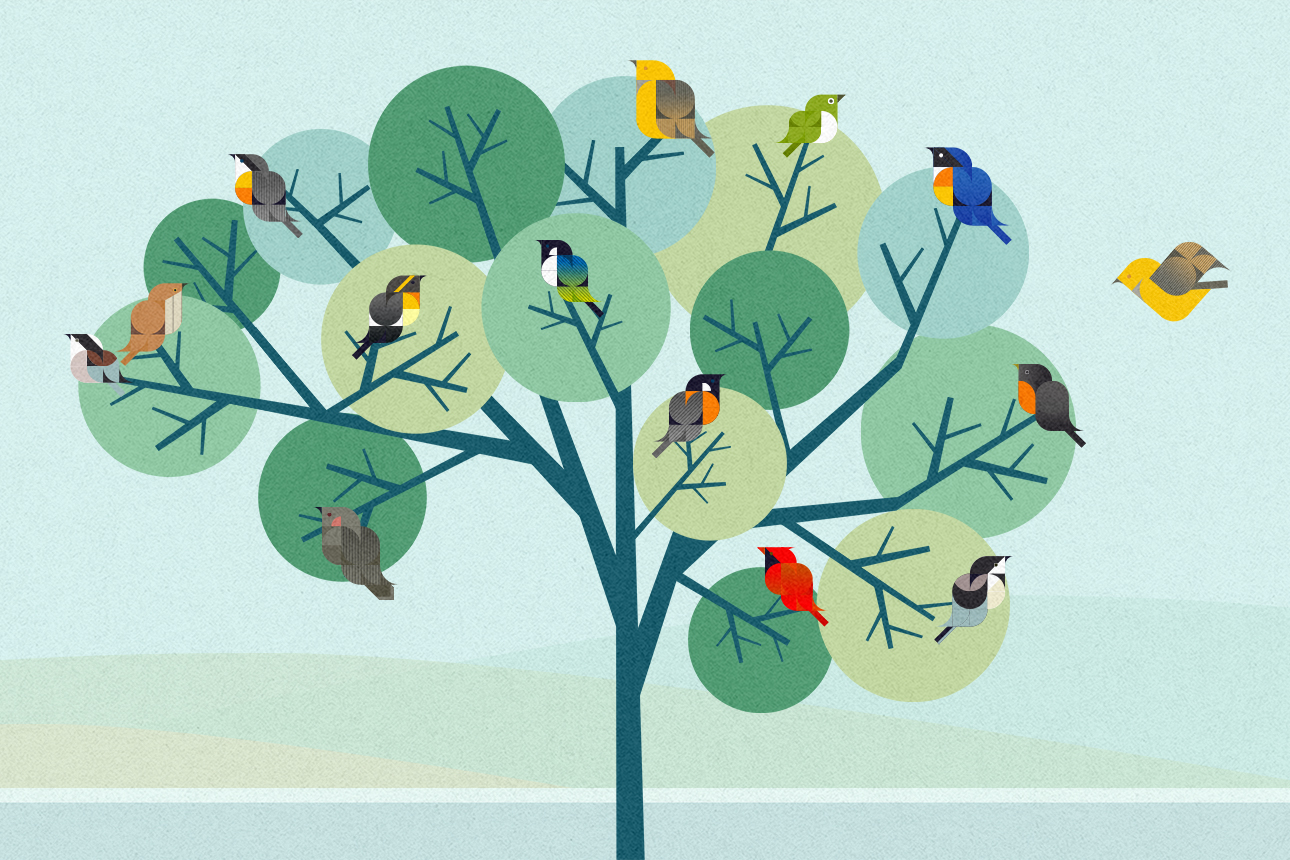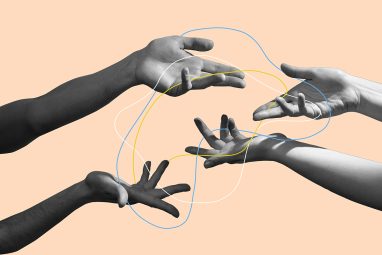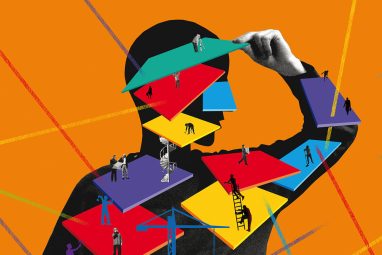Diverse Teams Thrive With Four Elements of Belonging
Learn how to better support neurodiversity, as explained in this excerpt from the forthcoming book The Canary Code.
News
- Identity-based Attacks Account for 60% of Leading Cyber Threats, Report Finds
- CERN and Pure Storage Partner to Power Data Innovation in High-Energy Physics
- CyberArk Launches New Machine Identity Security Platform to Protect Cloud Workloads
- Why Cloud Security Is Breaking — And How Leaders Can Fix It
- IBM z17 Mainframe to Power AI Adoption at Scale
- Global GenAI Spending to Hit $644 Billion by 2025, Gartner Projects

Carolyn Geason-Beissel/MIT SMR | Getty Images
Jessica is an ace data analyst; her mind excels at seeing connections that others miss. For many years, she delivered outstanding work and supported her company with system improvement suggestions. And then her work life crumbled — along with the walls of her cubicle, which the company decided to take down.
“It will be wonderful,” her boss insisted. “It will be light and bright and open and collaborative.”
No. Not wonderful, not for Jessica.
For one thing, Jessica has congenital cataracts. Fighting and avoiding glare has been a lifelong exercise, and although “light and bright” might be desirable for others, it is detrimental to her health.
But her vision difficulties are just a part of the problem. She is sensitive to many aspects of her environment. The sensation of the forced air from the industrial office vents is both unpleasant and distracting. The walls of the cubicle protected her from the worst of it. In the open office, that protection would be lost.
And then there was the horror of having her back exposed. Jessica had always been “jumpy,” easily startled. Arranging her desk in her cubicle to face the entrance helped her feel safe. With the sense of physical safety gone, how would her glorious, data-attuned brain produce the exceptional work it had delivered for so many years?
Managers brushed off Jessica’s concerns with comments like “Oh, you will come to like it.” She did not. Her well-being and productivity suffered in an open office. She suffered in the open office, physically and emotionally, needing to hide just to breathe. Still, managers denied her requests to work from home as much as some of her colleagues could.
After emotionally struggling for a while and ready to quit, Jessica broke down in her therapist’s office. Fortunately, the therapist connected the dots. She left the office with a diagnosis of autism and an accommodations letter.
Soon after, the COVID-19 pandemic exposed just how outdated in-office work had become. Jessica — mind and body — could now deliver her outstanding work from home. She also discovered her autistic pride and a passion for neuroinclusion, becoming a founding member of the neurodiversity-focused Umbrella Alliance and an advocate for others.
Jessica’s employer at that time welcomed some of the aspects of her autistic mind — or rather the results it produced. But our minds work best when the needs of our bodies for accommodating physical environments are met. They work best when our emotions are acknowledged and respected, not dismissed with generic platitudes.
We are whole people. And every aspect of us matters.
We Feel Belonging in Our Bodies
Neurodiversity is sometimes referred to as cognitive diversity, brain differences, or information-processing differences. But that is a limiting definition, especially if by “cognitive” we mean thought patterns, ideas, problem-solving methods, and intellectual perspectives — mental manifestations that can be explained in words and diagrams. Neurodiversity also encompasses our emotions and our bodies, which are intertwined. According to Nick Walker, neurodiversity is best understood as diversity in bodyminds and the entire nervous system.
Dyspraxia may interfere with intended movement, and Tourette syndrome may result in movements that are not desired. People with sensory sensitivities respond to environmental stimuli more intensely than others.1 We can be overwhelmed to the point of shutting down by what others would perceive as “normal” noise levels or “hardly noticeable” smells. On the positive side, research shows that ADHDers can use physical activity and body movement to effectively improve attention and emotional regulation, and the lived experience of people describing other forms of developmental or acquired neurodivergence suggests the same.2
The mind-body distinction is, in many ways, artificial. Our information processing and our cognition are very much embodied. For example, have you tried to think logically — or remember where you’ve put your keys — in the midst of major personal events? Our thinking is tied to our emotions. Have you tried to think logically — or relax emotionally — in a freezing wind or in sticky, suffocating heat? Our thinking and our emotions are tied to our bodies.
We are whole people. Our work experience, too, involves the whole person — and whole people require a holistic approach to inclusion. We can’t experience belonging at work when our bodies do not feel safe. Jessica needs holistic belonging to flourish fully, and holistic belonging is supported by holistic inclusion. We all need social, cognitive, emotional, and physical/sensory neuroinclusion to feel and be our best.
Holistic Neuroinclusion
The complexity of neurodiversity and its manifestations defies simplistic inclusion solutions. Unlocking neurodivergent — and, overall, human — potential requires supporting a sense of holistic belonging. This means a deep respect for differences in how our thinking, emotions, bodies, and relationships work best.
It also means that organizations can’t be truly inclusive without holistic inclusion. Flexibly aligning work’s social, cognitive, emotional, and physical/sensory aspects with how different humans experience life best also means supporting their ability to perform their best.
Social (Neuro)inclusion
When people refer to inclusion in the workplace, often the focus is on social inclusion — being invited to participate in the actual or metaphorical party, meeting, conversation, and decision-making process. Of course, social inclusion is vital. Equitable access to social interaction and support is essential to inclusive environments. Social exclusion is processed as physical pain.3
However, forms of human social needs differ. If social inclusion is approached as one-size-fits-all, it can turn into mandatory fun, collaboration overload, and pressure to fit in — gratefully.
The social inclusion of neurodivergent people in the workplace requires rethinking traditional neuronormative expectations of workplace socialization. Inclusion efforts must aim to create environments where people wired to need different levels and forms of social interaction feel accepted and valued. Here are some key considerations for social aspects of neuroinclusion:
- Although some employees enjoy parties or small talk, others feel included when colleagues respect their privacy and enjoy fewer but deeper interactions. Large group gatherings or social events energize some. The same events might be physically draining or anxiety-provoking for others, who are more likely to feel included when in smaller or task-focused settings.
- A neuroinclusive social environment means that employees should be welcomed but never pressured to participate in social activities. The ability to opt out of social events without fear of judgment or repercussions is as essential as being invited to social events.
- Understanding that engagement and commitment can be expressed in different ways can expand social inclusion and the valuing of different personality styles. Hosting parties might be one way of expressing engagement at work. Quietly developing groundbreaking products communicates engagement at least as much.
For too long, social inclusion at work was conditional on individuals changing themselves or being actively trained to “fit in”— think of assertiveness training for women or accent reduction programs for immigrants. The key to true social inclusion in the workplace is ditching the idea of making everyone fit into a rigid social mold. It is about reshaping the culture to allow for different ways of being and participating in the community. For example, Twilio, a tech company committed to the idea that supporting diversity means supporting people in being themselves, banned the use of the phrase “culture fit.”
Cognitive (Neuro)inclusion
Cognitive diversity is often defined as diversity in knowledge processing and perspectives. This diversity enhances team performance and helps build more innovative, productive, and successful organizations. But ensuring these rewards takes some work. To unlock productivity that comes from the diversity of thinking, working, and decision-making styles, with their underlying experiential and neurobiological bases, organizations must change some prevalent practices to ensure cognitive (neuro)inclusion.
Removing access barriers requires hiring for culture-add and creating environments that support multiple thinking and productivity styles. This enriches organizations by introducing additional perspectives and lived experiences.
For example, people with more contextual and systemic thinking can balance groups of individual-focused thinkers. Without that balance, groups are prone to making decisions shaped by the fundamental attribution error, such as trying to “fix” people when systems change is required.
People intuitively see their way of thinking as “right,” which may lead to hiring bias — often in the name of “culture fit” — that limits cognitive diversity. Hence, developing transparent and intentional processes for culture-add and thinking-add hiring is crucial for overcoming neurodiversity hiring gaps and ensuring the diversity in thinking styles that is essential to quality decision-making.
Removing success barriers requires respect for diversity in productivity styles. Productivity gurus often sell one-size-fits-all approaches, but cognitive diversity means there is no one best way to work. Some people work best in the morning, others at night. Some need at least three to four hours of uninterrupted deep work, while others thrive on 25-minute Pomodoro productivity sprints. Respecting the need for different schedules, communication mechanisms, and work environments is the key to unlocking neurodivergent — and, overall, human — productivity.
Cognitive diversity and inclusion in leadership teams might be particularly important to developing lasting and systemic solutions to the problems of systemic and intersectional neurodiversity exclusion. Organizations must systemically guard against overrepresenting one thinking style — for example, Western or linear — in their leadership and decision-making. This calls for changes to multiple organizational processes, such as making communication inclusive and accessible by supporting multiple communication modalities. Leadership development and promotion mechanisms should also be aligned with the goal of neurocognitive diversity.
Emotional (Neuro)inclusion
Neurodiversity is, to a large extent, a diversity in the intensity of emotions and in the types of emotions we are likely to experience more often. Many neurodivergent people feel a range of emotions with amplified intensity. Hence, neurodiversity inclusion requires emotional inclusion. Moreover, human well-being, in general, requires emotional inclusion.4
Suppressing and masking our feelings is taxing and stressful, and outdated norms of professionalism interfere with normal human emotional expression, including compassion and empathy, and with emotional well-being.5 Those who are culturally marginalized or disabled pay extra for each stigmatized identity.
Human feelings are an essential part of our makeup; they are a driving force behind our motivations, effort, and innovation. Our sense of justice has an emotional as well as a cognitive component.6 Yet, few organizations practice emotional inclusion by normalizing authentic emotional expression at work. In traditional business environments, showing harmless emotion can cost the person a job — or at least a promotion. I once cried at a large organizational gathering out of love for my colleagues, which might have cost me a long-promised promotion. But I also know other women who have been penalized for “not showing enough emotion” according to gendered expectations. Neither is fair. People wear their emotional energy in different ways, and any nonharmful way is perfectly fine.
Removing access barriers associated with emotional diversity requires reconsidering capricious expectations of emotional expression based on cultural biases and pop psychology. For example, some hiring managers believe that showing “too much enthusiasm” is a sign of faking, whereas it could simply be enthusiasm.
Of course, some behavioral expressions of emotions can be destructive. For example, envy that turns into bullying and sabotage, harming another individual, is not the same as acknowledging that sometimes people experience envy.7 Entitlements should end where harm to others begins. Organizations are responsible for developing mechanisms that maximally prevent and address harm to employee well-being caused by other employees or customers.
Physical and Sensory (Neuro)inclusion, Accessibility, and Sensory Safety
The term inclusion, when applied to various disabilities or neurodivergence, is broader than accessibility and accommodation. Inclusion has a crucial element of nondiscrimination, whereas with accessibility and accommodation, various forms of discrimination may still occur. Many workers can testify that compliance with minimal legal accessibility requirements or the grudging provision of accommodations does not ensure a welcoming environment or prevent social exclusion and bullying. Going beyond accommodations and ending neurodiversity and disability discrimination require a systemic revision of all aspects of employment, including cultural norms and leadership development processes.
Workplaces that support physical aspects of neuroinclusion are accessible, safe, and supportive of diverse sensory needs. Here are some ways organizations can practice physical inclusion:
- To remove access barriers, organizations should ensure that their job announcements and application systems are both accessible and nondiscriminatory. Physical environments should also be accessible to all individuals, regardless of ability. This may involve providing wheelchair ramps, elevators, and accessible restrooms and designing spaces that are easy to navigate for individuals with visual, hearing, balance, and other differences. It is also important to create welcoming environments for people who have sensory sensitivities and those who might feel sick in overstimulating environments. Ignoring sensory needs means excluding neurodivergent talent. Because our needs differ greatly, systems and spaces must be flexible.
- Removing success barriers also requires flexibility. Even people within the same “label” have different needs. For example, Jessica and I are both autistic women, but she needs to avoid glare, and I need all the sunlight I can get to prevent depression. Workplaces and work organizations should be flexible enough to support health and maximize the productivity of people with different needs through either supportive and adjustable spaces, adjustable schedules, or remote work.
Designing spaces that allow individuals to control their sensory environments, reduce distraction and discomfort, and maximize well-being helps neurodivergent talent thrive. When we create spaces that support well-being by removing the auditory, visual, and other stimuli that might be distressing or even painful for neurodivergent employees and provide opportunities for stimulation that are not distracting to others, we improve work environments for everyone.
Moreover, practicing holistic inclusion and welcoming differences in how humans think, feel, and experience our physical environments might be the key to belonging — the component of diversity, equity, inclusion, and belonging work that has been difficult to achieve for many organizations. Creating environments for belonging requires developing systems that are deeply and holistically inclusive — in ways that people can experience and sense with their entire being.
Excerpted from The Canary Code: A Guide to Neurodiversity, Dignity, and Intersectional Belonging at Work, by Ludmila N. Praslova. Copyright © 2024. Available April 23 from Berrett-Koehler Publishers.
References
1. H. Markram, T. Rinaldi, and K. Markram, “The Intense World Syndrome — an Alternative Hypothesis for Autism,” Frontiers in Neuroscience 1, no. 1 (November 2007): 77-96; and C. Meng, C. Huo, H. Ge, et al., “Processing of Expressions by Individuals With Autistic Traits: Empathy Deficit or Sensory Hyper-Reactivity?” PLOS One 16, no. 7 (July 9, 2021): 1-17.
2. Y. Xie, X. Gao, Y. Song, et al., “Effectiveness of Physical Activity Intervention on ADHD Symptoms: A Systematic Review and Meta-Analysis,” Frontiers in Psychiatry 12 (Oct. 25, 2021): 1-12; and J. Edry, “Moving Forward: Reflections on Autism, Neurodiversity, Brain Surgery, and Faith” (self-pub., Jacki Edry, 2021).
3. M. Zhang, Y. Zhang, and Y. Kong, “Interaction Between Social Pain and Physical Pain,” Brain Science Advances 5, no. 4 (December 2019): 265-273.
4. C.L.A. Zurbriggen, M. Venetz, S. Schwab, et al., “A Psychometric Analysis of the Student Version of the Perceptions of Inclusion Questionnaire (PIQ),” European Journal of Psychological Assessment 35, no. 5 (September 2019): 641-649.
5. D. Miller, J. Rees, and A. Pearson, “‘Masking Is Life’: Experiences of Masking in Autistic and Nonautistic Adults,” Autism in Adulthood 3, no. 4 (December 2021): 330-338.
6. J. Decety and K.J. Yoder, “Empathy and Motivation for Justice: Cognitive Empathy and Concern, but Not Emotional Empathy, Predict Sensitivity to Injustice for Others,” Social Neuroscience 11, no. 1 (2016): 1-14; and D. De Cremer and K. van den Bos, “Justice and Feelings: Toward a New Era in Justice Research,” Social Justice Research 20, no. 1 (March 2007): 1-9.
7. R.P. Vecchio, “Negative Emotion in the Workplace: Employee Jealousy and Envy,” International Journal of Stress Management 7, no. 3 (July 2000): 161-179.





